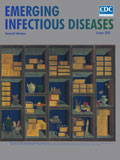
Volume 26, Number 10—October 2020
Synopsis
Community Treatment Centers for Isolation of Asymptomatic and Mildly Symptomatic Patients with Coronavirus Disease, South Korea
Altmetric
Abstract
As a part of measures to decrease spikes in coronavirus disease (COVID-19) cases and deaths outside of hospitals, the government of South Korea introduced a plan for community treatment centers (CTCs) to isolate and monitor patients with mild COVID-19 symptoms. We assessed outcomes of 568 patients admitted to 3 CTCs near Daegu. More (64.6%) women than men (35.4%) were admitted, and the mean age of patients was 36.0 years (SD +15.0 years). Among all patients, 75.7% remained asymptomatic while at the CTCs. The mean time patients remained at CTCs was 19.6 days (SD +5.8 days) from the day of diagnosis until our study ended on March 23, 2020. Because they offer appropriate clinical triaging and daily monitoring for patients, CTCs are a safe alternative to medical institutions for asymptomatic or mildly symptomatic patients with COVID-19.
Since initial reports of coronavirus disease (COVID-19) from Wuhan, China, 267,013 confirmed COVID-19 cases have been reported from 184 countries, as of March 22, 2020 (1). In South Korea, severe acute respiratory syndrome coronavirus 2 (SARS-CoV-2), which causes COVID-19, was detected in a person from China who entered the country from Wuhan on January 19, 2020 (2). After an outbreak was identified among a religious group in Daegu and the neighboring regions on February 18, 2020, the cumulative number of cases in South Korea increased dramatically (3). Because of the sharp increase in cases in this region, it was impossible to accommodate all patients in hospitals. The shortage of hospital beds left >2,000 persons with confirmed COVID-19 waiting many days at home for a hospital admission. Unfortunately, several persons died at home while waiting or during transportation to the hospital. As a part of measures to decrease spikes in COVID-19 caseloads in and deaths outside of hospitals, the government of South Korea converted private dormitories and state-run institutions into community-based isolation facilities for patients with laboratory-confirmed COVID-19, but mild or no symptoms. These community treatment centers (CTCs) enabled the efficient use of medical institutions and compensated for the shortcomings of self-isolation. South Korea opened its first CTC on March 2, 2020, and by March 19, 2020, 16 CTCs with a total of 3,818 beds were distributed across the country. We describe the operating processes of 3 CTCs near Daegu, South Korea, and analyze the clinical characteristics and disease progression in admitted patients.






















.png)











No hay comentarios:
Publicar un comentario